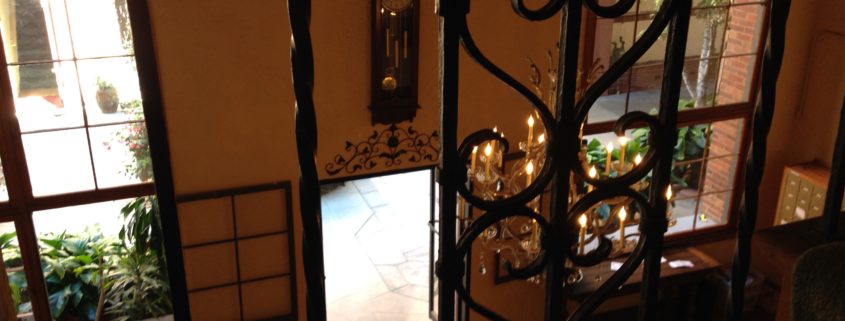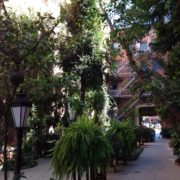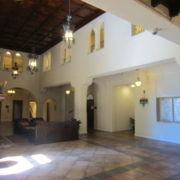Hollywood (the district, not the ‘idea’) has some serious history. When I was a kid my sister and I left Tulsa and joined my older sister and our mother, who had been living there for a couple of years. My mom wanted to be there to simply be insinuated in the glamor, she didn’t want or need to work in the Industry. She was steeped in the history, the Hollywood stuff. And though she would have denied it up and down, I suspect she even embraced the seedy side, and oh yeah, that place was seedy. This was Hollywood, circa 1979.
In our apartment at Wilcox and Yucca, the TV was always on. I watched mostly on weekend mornings, when my mom held absolute sway over the programming. Well, that’s not entirely accurate, I watched TV all the time, and my mom almost always had sway. Luckily my sisters and I were largely simpatico on scheduling, “Three’s Company,” “Elvira,” “Quincy;” stuff like that. It was the Saturday mornings I really remember though. When I lived in Tulsa, I got to watch cartoons in a solid, Trix-fueled, four hour block. However, in Hollywood, Mom’s control of the airwaves was strongest on these mornings, where she enjoyed a Tarreyton-fueled four hour block of documentaries on Channel 9, like “World at War.” Occasionally we would see Abbott and Costello movies, which I especially enjoyed, particularly the Revolutionary War/ghost movie “The Time of Their Lives.”
Saturdays were all in black and white, it seemed so distant to me, irrelevant really. I couldn’t see any connection to myself (I was only 12 years old), and any connections that my mom may have mentioned were promptly ignored. She quickly got used to that but it never stopped her from reminiscing aloud, a soft melancholy musing that, at my age, I could not understand at all. Despite all the black and white blurry images of big guns firing at empty stretches of ocean, “World at War” slowly got my attention, especially any time they mentioned the Hollywood Canteen. That would get me to imagining the romance of being a soldier, getting to dance with starlets for a few nights before getting shipped off to a probably stoic and noble death on some unpronouncable island in the Pacific. I wondered where it was located, this Canteen, it was probably close to my building, the Lido. My mom likely told me the exact location 11 or 12 times and I just filed it away with her other stories. Too bad.
Hollywood was dirty, it had a lot of adult stores and adult theaters, with prostitutes perambulating day and night. The seedy was fascinating to me, though a little scary. I think I caught the same vibe I had from others in my family too, we were all engaged in this grand adventure. It made us stick together a little more than we would have in Peoria or even Whittier. Or Tulsa. Settling in, I found out a few things about my building, that right before I had moved in, a resident actor had been murdered on our floor. I knew he was on the show “Mary Hartman, Mary Hartman,” but I never saw it because by the time I got to Hollywood it had been cancelled two years already. In Tulsa it had been all “HeeHaw” and “60 Minutes,” so no real chance to recall it from there. Some nights when I exited our dwelling I would walk down our hall going away from Victor’s apartment with a little more pep in my step, just in case his ghost was not as friendly as Lou Costello’s Horatio Prim.
I also knew about the old people in the lobby. Mom told me right away that some (many) of them had been silent movie actors. For me though, 50 years before my birth might as well have been 10, or 5. It just didn’t matter. Man, if I only knew. My 50 year old self would have loved to go back and take a tape recorder to the lobby, where those retirees would have gladly filled up cassette after cassette with stories. But I never thought about myself at 50, being so old, it would just be depressing. Every once in a while at the Lido pool I would set down my Mad Magazine and wonder about them, sitting as they were only a few feet away inside the lobby, while I just sat in the sun hearing and smelling the cars pass by on Wilcox. Sometimes I’d formulate a plan to talk to them a bit but the thought of saying something stupid (or of them dying in front of me – then what would I do?!) would make me pick up my mag and continue on with the Don Martin strips. Now those people are all gone, hopefully someone else (probably older than me) picked up a bit of oral history of the real Hollywood that was around me the whole time.
Mom was interested in everything Hollywood though, and she tried her best. She took us to some cool places, Houdini’s house, or over to see the nude staues in front of the Sheikh’s mansion on Sunset. Back then the Vogue, Fox and Paramount theaters were all open and we saw movies all the time. Some movies I loved, a few I fell asleep in, but the Boulevard theater palaces were all magic to me, it was like going into another world. These things I absorbed then were about the extent of my knowledge though, I had no idea the Lido had been built in the 20’s, had once had a bar, or that famous people had lived there too, at least for a spell. It wouldn’t have menat anything to me then to find out director Ed Wood used to frequent the Lido bar, always in drag. All of this I found out too late to stoke my childhood wonder, for although many years later Google may have been available, my childhood was not.
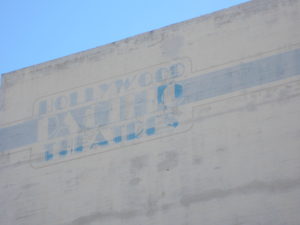
Though the shell remains, this fading outside paint is about all I have to connect to my favorite theater.
One day I saw “Sunset Boulevard,” a movie I loved then and now, but had no idea that William Holden’s Joe Gillis lived right on Ivar, at the Aldo Nido. Even 12 year old me would have loved to take that little one block hike up to see a building that looked exactly as it did in 1950. Unknowingly (to me), the Lido and the Alto Nido shared rain showers and little earth tremors together over those years, it was right there. It even looks the same today, almost exactly. I probably went to school with a kid or kids that lived there, maybe they didn’t know, or care about William Holden either. I remember seeing one of the “Death Wish” movies on the Boulevard but didn’t know until I was in my forties that Charles Bronson had filmed a movie in the Lido only 4 years before I had moved in. Nostalgic people, by necessity, have to do a lot of catch up. It is kind of like a job, but a pleasureable one.
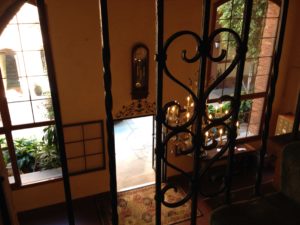
Villa Elaine lobby, then and now
A few years later we moved into the Villa Elaine, a building on Vine Street that I had no idea was also shrouded in the historical legend of the “guess who lived there” variety. I only knew that the pool was not as clean as the Lido’s, that there were a lot of bugs everywhere, and that an actor named Terence Knox lived in a neighboring courtyard flat. He got his break on “St. Elsewhere” that year and moved into presumably tonier dwellings. It was 1982, the building fascinated me but all of us residents knew the place had seen better days. I suspected my neighbors were all on the decline too, but I hoped to not have to count myself among them. Living there, I wasn’t ever sure.
Again, sometime much later, I found out Man Ray had lived there, as well as Frank Sinatra. My twenty-something art student self would have loved to go back and appreciate the stuff about Man Ray. Frank Sinatra had apparently lived for short periods at both the Lido and the Villa Elaine, how did I know I was going to become a huge Sinatra (Capitol era) fan in college 10 years hence? And how did I know Marilyn Monroe lived for a short time at the Hotel Hollywood, a place that was a short two block walk down Yucca from the Lido? I found that out while staying there for a night in 2014. Archibald Leach (Cary Grant) lived at the Hotel Hollywood too. There were and are these little connections everywhere, crisscrossing Cahuenga, Ivar, De Longpre and La Mirada. From Buster Keaton to Jodie Foster, film crews ahd been all over the Boulevard and all of its surrounding streets for decades. And almost every old building was an actor’s way station to live or work at some time. I’m still uncovering a lot of stuff, even as the remnants of old Hollywood (with an assist from the ’94 Northridge quake) grudgingly give way to multi-use mid-rise complexes. Most of the theaters are closed now too. One thing I’m grateful for is that both the Lido and the Villa Elaine look the same as when I lived there, they’re just missing their pools. And as for the Hollywood Canteen, glimpsed as I saw it in black and white on an old barely-color television, well, it closed its doors a few months after the end of the war and (I guess) became 15 or 20 other things before a mixed-use building was erected on the site. I had no idea then that I walked past the location at 1451 Cahuenga many many times as a kid.
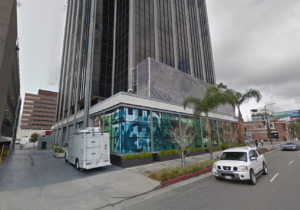
Kinda, sorta, the location of the old Hollywood Canteen
Surely my mom knew some of the things I now know, she was trying to tell me all the time. Aside from her letting me look at the Hollywood Babylon book (because of its lurid photography) not much got in and stayed there (that’s how I knew Sal Mineo had been killed nearby). And surely the old people in the Lido lobby knew all about Hollywood’s microhistory too, but I was too hesitant to engage with them. If only I knew back then this one little thing; there is a great value to learning things you might only appreciate later.

